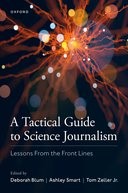3 Journals, Peer Review, and Preprints

- Author: Ivan Oransky
- Full Title: 3 Journals, Peer Review, and Preprints
- Type: #snippet✂️
- Document Tags: #sci_comms
- URL: https://academic-oup-com.ezproxy.bu.edu/book/44157/chapter/372344592
Highlights
- Ask a statistician. For close to two decades, I’ve been telling my students at New York University’s Science, Health, and Environmental Reporting Program to keep a biostatistician in their back pocket. Many of them, along with epidemiologists, have soared in popularity during the Covid-19 pandemic, which makes them easier to find, but they field lots of calls from the media. It’s worth developing a relationship with someone you can send a study for a quick sniff test. (View Highlight)
- Look for the limitations. All studies have limitations, but the ones I trust are the ones that spell them out. At the very least, including limitations in your work makes for a better story. (View Highlight)
- Size matters. There are no bright lines for how many samples, animals, or participants need to be in a study for it to be meaningful, although one hopes that researchers performed what’s known as a power calculation to figure that out. For rare conditions, small studies can tell us a lot. Still, in general, the larger the study, the more useful it is. (View Highlight)
- Exert control. Showing that a group of people did better after a particular treatment or intervention is all good and well, but how do you know they wouldn’t have improved without that treatment? That’s where a control group of people who didn’t receive the intervention comes in. If a paper doesn’t include such a group—known as a control group—it’s unlikely to be that useful or worth writing about. (View Highlight)
- Correlation is not causation. Is there some other plausible explanation for the findings? And a related question: Did the study test what matters directly or use what is known as a surrogate marker or proxy? In other words, did it test whether people had heart attacks or died, or did it test cholesterol? Did the study look at an esoteric test or the outcome that really matters? A clinical study or psychological experiment may be carefully done but irrelevant to most people. (View Highlight)
- One source is EurekAlert, a service of the American Association for the Advancement of Science that distributes press releases from journals, universities, and other institutions. Many of these releases are embargoed—more on that later—and most link to a study. Make sure you read the whole study, not just the abstract. Public information officers at universities and publishers are typically more than happy to provide it if it’s not available directly, and that’s true of papers you find elsewhere, too. (View Highlight)
- Where was the study published? High-profile journals, particularly those that put out press releases, command the lion’s share of press coverage. Competition to appear in their pages could mean robust or even brutal systems to separate the wheat from the chaff. But their peer reviewers aren’t always the right kinds of experts. Don’t be afraid to look at specialty journals with slightly lower profiles. They may be less likely to attract headline-worthy papers, but their peer reviewers probably put studies through their paces better. (View Highlight)
